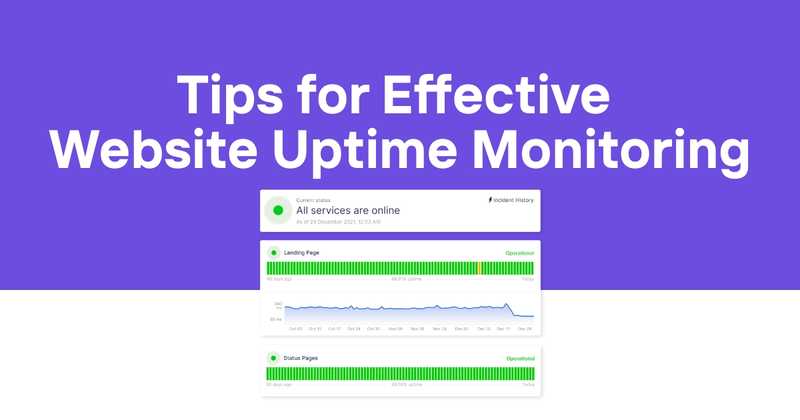Tips for Effective Website Uptime Monitoring
Introduction
Reliability is the cornerstone of any successful web application. As a developer, ensuring your websites and APIs are consistently available is crucial for maintaining user trust and satisfaction. This is where website uptime monitoring becomes an invaluable tool in your arsenal. In this comprehensive guide, we'll explore the ins and outs of website uptime monitoring, its importance for developers, and how to implement effective strategies to keep your digital services running smoothly.
Table of Contents
- Understanding Website Uptime
- The Importance of Uptime Monitoring
- Key Features of Uptime Monitoring Tools
- Types of Uptime Monitoring
- Setting Up Effective Monitoring
- Interpreting Monitoring Data
- Responding to Downtime
- Best Practices for Developers
- Advanced Monitoring Techniques
- Integrating Uptime Monitoring into Your Workflow
- The Future of Uptime Monitoring
Understanding Website Uptime
Website uptime refers to the percentage of time a website or web service is operational and accessible to users. It's typically measured as a percentage, with 100% uptime being the ideal goal. However, achieving perfect uptime is challenging due to various factors such as server maintenance, network issues, or unforeseen technical problems.
For example:
- 99% uptime = 3.65 days of downtime per year
- 99.9% uptime = 8.76 hours of downtime per year
- 99.99% uptime = 52.56 minutes of downtime per year
While these numbers might seem small, even brief periods of downtime can have significant impacts on user experience and business operations.
The Importance of Uptime Monitoring
For developers, uptime monitoring is crucial for several reasons:
- User Experience: Downtime directly affects user satisfaction and can lead to lost customers.
- Reputation Management: Consistent availability builds trust and credibility for your service.
- Performance Optimization: Monitoring helps identify and address issues before they escalate.
- SLA Compliance: Many service-level agreements require specific uptime percentages.
- Resource Allocation: Accurate uptime data helps in making informed decisions about infrastructure investments.
Implementing a robust uptime monitoring system allows developers to proactively manage their applications, ensuring optimal performance and reliability.
Key Features of Uptime Monitoring Tools
When selecting an uptime monitoring tool, developers should look for the following essential features:
- Real-time Alerts: Immediate notifications when issues are detected.
- Multi-location Monitoring: Checks from various geographic locations to ensure global accessibility.
- Detailed Reporting: Comprehensive insights into uptime statistics and trends.
- API Monitoring: Ability to monitor both websites and API endpoints.
- Custom Check Intervals: Flexibility in setting monitoring frequency.
- SSL Certificate Monitoring: Alerts for expiring SSL certificates.
- Integration Capabilities: Easy integration with existing development and communication tools.
- Historical Data Storage: Long-term data retention for trend analysis.
Types of Uptime Monitoring
Developers should be familiar with various types of uptime monitoring to ensure comprehensive coverage:
- HTTP(S) Monitoring: Basic checks for website availability.
- Ping Monitoring: Tests network connectivity to servers.
- TCP Port Monitoring: Verifies specific service ports are open and responding.
- DNS Monitoring: Ensures domain name resolution is working correctly.
- Content Monitoring: Checks for specific content or keywords on a page.
- Transaction Monitoring: Simulates multi-step user interactions to test functionality.
Each type serves a specific purpose and can be crucial depending on your application's architecture and requirements.
Setting Up Effective Monitoring
To set up an effective uptime monitoring system:
- Identify Critical Endpoints: Determine which pages, APIs, and services are essential to monitor.
- Set Appropriate Check Intervals: Balance between timely alerts and avoiding unnecessary load on your servers.
- Configure Alert Thresholds: Define what constitutes an issue (e.g., response time > 2 seconds).
- Establish Alert Channels: Set up notifications via email, SMS, or integration with team communication tools.
- Create Escalation Procedures: Define a clear process for handling alerts, including who should be notified and when.
Example Configuration:
endpoints:
- url: https://api.example.com/health
interval: 60s
timeout: 10s
alert_threshold: 2 failures
- url: https://www.example.com
interval: 300s
content_check: "Welcome to Example"
alerts:
- type: email
recipients: [[email protected], [email protected]]
- type: sms
number: +1234567890
Interpreting Monitoring Data
Effective uptime monitoring generates a wealth of data. Developers should focus on key metrics such as:
- Uptime Percentage: The overall availability of your service.
- Response Time: How quickly your service responds to requests.
- Error Rates: The frequency of failed checks or error responses.
- Geographic Performance: How your service performs across different regions.
Use this data to:
- Identify patterns in downtime or performance issues
- Set realistic SLAs based on historical performance
- Prioritize infrastructure improvements
Consider creating dashboards that visualize these metrics for easy interpretation:
| Metric | Last 24 Hours | Last 7 Days | Last 30 Days |
|---|---|---|---|
| Uptime | 99.98% | 99.95% | 99.93% |
| Avg Response Time | 287ms | 302ms | 295ms |
| Error Rate | 0.02% | 0.03% | 0.04% |
Responding to Downtime
When downtime occurs, follow these steps:
- Verify the Issue: Confirm the problem is real and not a false positive.
- Assess the Impact: Determine the scope and severity of the downtime.
- Communicate: Inform relevant team members and, if necessary, users about the issue.
- Investigate and Resolve: Identify the root cause and implement a fix.
- Post-Incident Review: Conduct a thorough analysis to prevent similar issues in the future.
Example Incident Response Workflow:
A[Alert Triggered] --> B{Verify Issue}
B -->|Real Issue| C[Assess Impact]
B -->|False Positive| D[Update Monitoring]
C --> E[Notify Team]
E --> F[Investigate]
F --> G[Implement Fix]
G --> H[Verify Resolution]
H --> I[Post-Incident Review]
Best Practices for Developers
To maximize the benefits of uptime monitoring:
- Implement Redundancy: Use multiple monitoring services to avoid single points of failure.
- Monitor from Multiple Locations: Ensure your service is accessible globally.
- Set Up Synthetic Transactions: Create scripts that simulate user interactions to test critical paths.
- Use Status Pages: Maintain a public status page to communicate service health to users.
- Regularly Review and Update: Continuously refine your monitoring setup as your application evolves.
- Implement Gradual Rollouts: Use techniques like canary deployments to catch issues before they affect all users.
- Automate Where Possible: Use tools that can automatically mitigate common issues without human intervention.
Advanced Monitoring Techniques
As your application grows, consider implementing these advanced techniques:
- Real User Monitoring (RUM): Collect performance data from actual user sessions to complement synthetic monitoring.
- API Versioning Monitoring: Track usage of different API versions to plan deprecations and upgrades.
- Dependency Monitoring: Monitor third-party services and APIs that your application relies on.
- Performance Profiling: Use tools to identify performance bottlenecks in your application code.
- Log Analysis: Implement centralized logging and use log analysis tools to correlate issues with application events.
Example API Version Monitoring Dashboard:
| API Version | Usage % | Avg Response Time | Error Rate |
|---|---|---|---|
| v1 | 15% | 350ms | 0.5% |
| v2 | 75% | 280ms | 0.2% |
| v3 (beta) | 10% | 260ms | 1.2% |
Integrating Uptime Monitoring into Your Workflow
To make uptime monitoring an integral part of your development process:
- Include Monitoring in CI/CD: Automatically update monitoring configurations when deploying new features.
- Link Alerts to Issue Tracking: Integrate your monitoring system with tools like Jira or GitHub Issues.
- Use ChatOps: Integrate alerts and commands into team chat platforms for quick responses.
- Implement SLO Tracking: Set and monitor Service Level Objectives (SLOs) to maintain quality standards.
- Conduct Regular Reviews: Schedule periodic team reviews of monitoring data and incident responses.
Example Workflow Integration:
A[Code Repository] --> B[CI/CD Pipeline]
B --> C[Deployment]
C --> D[Uptime Monitoring]
D --> E{Alert Triggered?}
E -->|Yes| F[Incident Response]
E -->|No| G[Regular Review]
F --> H[Issue Tracker]
G --> H
H --> A
The Future of Uptime Monitoring
As technology evolves, so does uptime monitoring. Keep an eye on these emerging trends:
- AI-powered Anomaly Detection: Machine learning algorithms that can predict issues before they occur.
- Serverless Monitoring: Adapting monitoring strategies for serverless and cloud-native architectures.
- IoT Device Monitoring: Extending uptime concepts to the Internet of Things.
- Blockchain Integration: Using distributed ledger technology for transparent and tamper-proof uptime reporting.
- Enhanced Privacy Compliance: Adapting monitoring practices to stricter data protection regulations.
Staying informed about these developments will help you future-proof your uptime monitoring strategies and maintain a competitive edge in delivering reliable web services.
By implementing Odown’s comprehensive website uptime monitoring and following these best practices, developers can significantly improve the reliability and performance of their web applications. Remember, uptime monitoring is not just about detecting failures—it's about proactively ensuring the best possible experience for your users and maintaining the health of your digital services.



